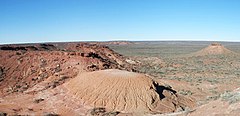| Lohan Cura Formation | |
|---|---|
| Stratigraphic range: Late Aptian-Albian ~117–100 Ma PreꞒ Ꞓ O S D C P T J K Pg N | |
 | |
| Type | Geological formation |
| Sub-units | Puesto Quiroga & Cullín Grande Members |
| Underlies | Río Limay Subgroup Candeleros Formation |
| Overlies | Mendoza Group La Amarga, Agrio & Bajada Colorada Formations |
| Thickness | 177 m (581 ft) |
| Lithology | |
| Primary | Mudstone, siltstone, sandstone |
| Other | Claystone |
| Location | |
| Coordinates | 39°36′S 69°24′W / 39.6°S 69.4°W / -39.6; -69.4 |
| Approximate paleocoordinates | 43°42′S 39°24′W / 43.7°S 39.4°W / -43.7; -39.4 |
| Region | Río Negro Province, Mendoza Province, Neuquén Province |
| Country | Argentina |
| Extent | Neuquén Basin |
| Type section | |
| Named by | Leanza & Hugo |
| Year defined | 1995 |
 | |
The Lohan Cura Formation is a geologic formation with outcrops in the Argentine provinces of Río Negro, Neuquén, and Mendoza. It is the second oldest Cretaceous terrestrial formation in the Neuquén Basin.
The Lohan Cura Formation unconformably overlies the terrestrial La Amarga Formation. In some places it also overlies the older marine Agrio and Bajada Colorada Formations of the Mendoza Group through the same Middle Miranican unconformity. It is in turn overlain by the Candeleros Formation of the Neuquén Group, separated by the Main Miranican unconformity. The Lohan Cura correlates with the Rayoso Formation in some areas.
Subdivision
The Lohan Cura Formation contains two members of roughly equal thickness. The lowermost member, Puesto Quiroga Member is approximately 85 metres (279 ft) thick. The lowest sediments in this unit are conglomerates, overlain by sandstones and siltstones. The upper two-thirds of the member consists mainly of shales. The Cullín Grande Member is the upper member within the formation, about 92 metres (302 ft) thick, which contains numerous sandstones displaying evidence of stream channels. Near the top of the sequence, siltstones and claystones become dominant.
Fossil content
Numerous tetrapod fossils have been recovered from the Cullín Grande Member of the Lohan Cura, including:
- several turtles (including 2 species of Prochelidella)
- rebbachisaurid sauropods (including Agustinia and Comahuesaurus)
- Ligabuesaurus
The rebbachisaurid Rayososaurus comes from the correlating Rayoso Formation in this same area.
Color key
|
Notes Uncertain or tentative taxa are in small text; |
| Dinosaurs of the Lohan Cura Formation | ||||
|---|---|---|---|---|
| Genus | Species | Presence | Notes | Images |
| Agustinia | A. ligabuei | Neuquén Province | Dorsal sacral and caudal neural arches, hindlimb elements, and pelvic fragments (the latter misidentified as osteoderms) |  |
| Comahuesaurus | C. windhauseni | Neuquén Province | "At least three individuals" | |
| Ligabuesaurus | L. leanzai | Neuquén Province | Partial skull and post cranial remains | |
| Limaysaurus | L. tessonei | Neuquén Province | MUCPv-205, a partial skeleton including the back of the skull, together with MUCPv-206, a second fragmentary skeleton including five caudal vertebrae and an ischium | 
|
| Rebbachisauridae indet. | unknown | Neuquén Province | ||
| Pterosaurs of the Lohan Cura Formation | ||||
|---|---|---|---|---|
| Genus | Species | Presence | Notes | Images |
| Ornithocheiriformes indet. | Indeterminate | Neuquén Province | "Isolated teeth" | |
| Turtles of the Lohan Cura Formation | ||||
|---|---|---|---|---|
| Genus | Species | Presence | Notes | Images |
See also
References
- Leanza et al., 2004, p.66
- ^ Weishampel, David B; et al. (2004). "Dinosaur distribution (Early Cretaceous, South America)." In: Weishampel, David B.; Dodson, Peter; and Osmólska, Halszka (eds.): The Dinosauria, 2nd ed., Berkeley: University of California Press. pp. 563–570. ISBN 0-520-24209-2.
- "Table 13.1," in Weishampel, et al. (2004). Page 267.
- ^ Ciaffi, A.; Bellardini, F. (2024). "Pterosaur teeth from the Southern Neuquén Basin (Patagonia, Argentina): New insights on the reconstruction of ornithocheiriform dental anatomy". Acta Palaeontologica Polonica. 69 (1): 73–86. doi:10.4202/app.01122.2023.
Bibliography
- Leanza, H.A.; Apesteguia, S.; Novas, F.E.; De la Fuente, M.S. (2004). "Cretaceous terrestrial beds from the Neuquén Basin (Argentina) and their tetrapod assemblages". Cretaceous Research. 25 (1): 61–87. Bibcode:2004CrRes..25...61L. doi:10.1016/j.cretres.2003.10.005. Retrieved 2019-02-16.
Further reading
- J. F. Bonaparte, B. J. González Riga, and S. Apesteguía. 2006. "Ligabuesaurus leanzai gen. et sp. nov. (Dinosauria, Sauropoda), a new titanosaur from the Lohan Cura Formation (Aptian, Lower Cretaceous) of Neuquén, Patagonia, Argentina". Cretaceous Research 27:364–376
- J. F. Bonaparte. 1999. "An armoured sauropod from the Aptian of northern Patagonia, Argentina". Y. Tomida, T. H. Rich, and P. Vickers-Rich (eds.), Proceedings of the Second Gondwanan Dinosaur Symposium, National Science Museum Monographs 15:1–12
- A. G. Martinelli, A. C. Garrido, A. M. Forasiepi, E. R. Paz, and Y. Gurovich. 2007. "Notes on fossil remains from the Early Cretaceous Lohan Cura Formation, Neuquén Province, Argentina". Gondwana Research 11:537–552
- L. Salgado, A. Garrido, S. E. Cocca and J. R. Cocca. 2004. "Lower Cretaceous rebbachisaurid sauropods from Cerro Aguada del León (Lohan Cura Formation), Neuquén province, northwestern Patagonia, Argentina". Journal of Vertebrate Paleontology 24(4):903–912
- Geologic formations of Argentina
- Lower Cretaceous Series of South America
- Cretaceous Argentina
- Albian Stage
- Aptian Stage
- Sandstone formations
- Siltstone formations
- Mudstone formations
- Fluvial deposits
- Neuquén Basin
- Fossiliferous stratigraphic units of South America
- Paleontology in Argentina
- Geology of Mendoza Province
- Geology of Neuquén Province
- Geology of Río Negro Province